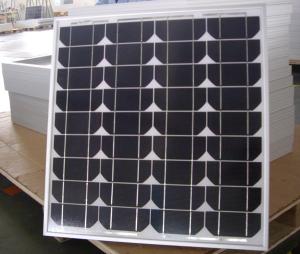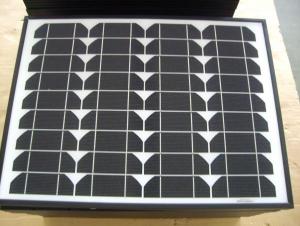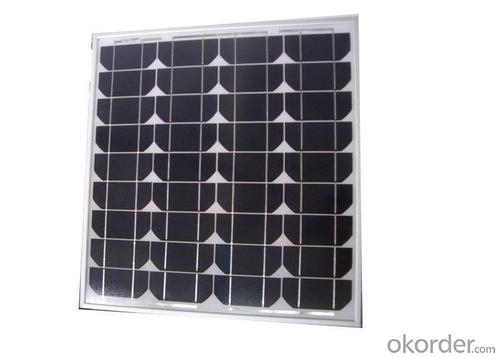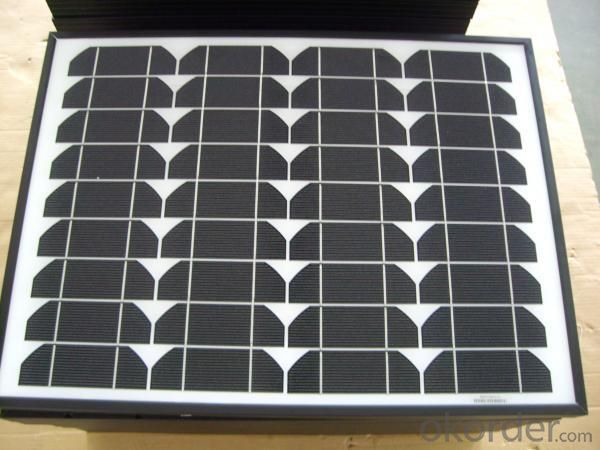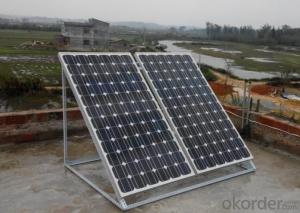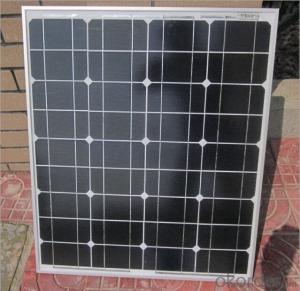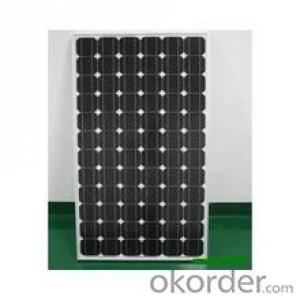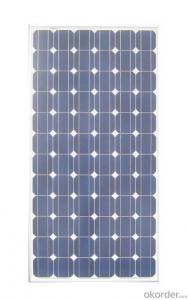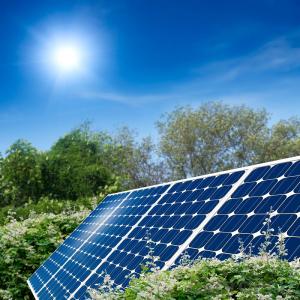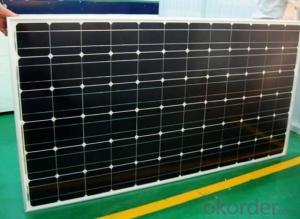Business-Grade Monocrystalline Silicon Solar Panels
- Loading Port:
- Shanghai
- Payment Terms:
- TT
- Min Order Qty:
- 1 watt
- Supply Capability:
- 100000/month watt/month
OKorder Service Pledge
OKorder Financial Service
You Might Also Like
CNBM Solar Mono Panels
Description of Monocrystalline Silicon Solar Panel
CNBM Solar photovoltaic (PV) Panel is designed for large electrical power requirements. It is the optimal choice for both on-grid and off-grid power systems. CNBM Solar panel offers high performance of power per square foot of solar array. Monocrystalline silicon(c-Si): often made using the Czochralski process. Single-crystal wafer cells tend to be expensive, and because they are cut from cylindrical ingots, do not completely cover a square solar cell module without a substantial waste of refined silicon. Hence most c-Si panels have uncovered gaps at the four corners of the cells.
Characteristics of Monocrystalline Silicon Solar Panel
I Solar Cell : High efficiency crystalline solar cell. Even if under the weak light, the solar module can produce maximum power output.
II Tempered glass (toughened glass): Anti-reflecting coating and high transmission rate glass increase the power output and mechanical strength of solar module.
III EVA and TPT: Using high quality EVA and TPT to prevent destroying and water.
IV AI frame: Without screw, corner connection. 6 holes on the frame can be installed easily.
V Junction box: Multi function junction box with water proof.
VI Long lifetime: ≥25 years; Less power decrease.
VII Good performance of preventing from atrocious weather such as wind and hails.
VIII Resisting moisture and etching effectively, not effected by geology.
Standard Test Conditions of Monocrystalline Silicon Solar Panel
The opto-electrical specifications shown below are stabilized values being measured at Standard Test Conditions, Irradiance: 1000W/m2, Spectrum: AM1.5 at 25°C, The info below is subject to manufacturing tolerances. Where appropriate minutes of measurement are available and are used for the dimensioning of the installation.
Advantages of Monocrystalline Silicon Solar Panel
• CNBM Solar performance guarantees for 25 years
• 2 years guarantee for workmanship
• Timeliness of delivery
Delivery of Monocrystalline Silicon Solar Panels
• 108 piece per pallet
• 22 pallets per container
CNBM International Corporation's products including Monocrystalline Solar Panel, Polycrystalline Solar Panel have received and enjoyed famous reputation in many countries and regions in the world .As a solar panel supplier in China, we strive to provide our customers with excellent service, superior products and unmatched value.
Characteristics
Power | 30W | 35W/40W |
Dimension | 440×550×25mm | 530×550×30mm |
Weight | 3.2kg | 3.8kg |
Tolerance | ±3% | ±3% |
The dimension of the modules can be changed according to the demand of clients
Limits
Operating Temperature | –40 °C to +85°C |
Storage Temperature | –40 °C to +85°C |
Max System Voltage | 700V |
Guarantee
Products Guarantee | 2 yrs free from defects in materials and workmanship |
Performance Guarantee | No less than 90% within 10yrs and no less than 80% within 25yrs |
Certificates | IEC, ISO, TUV, CE |
The Professional Production Line1
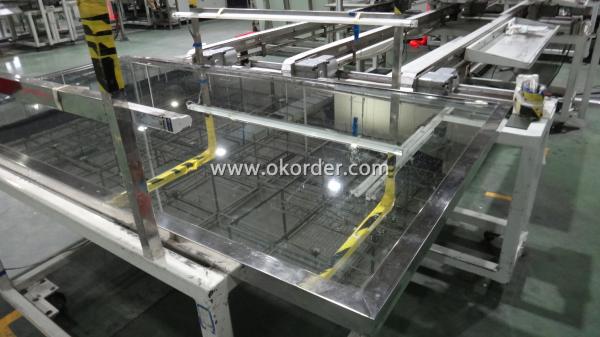
The Professional Production Line 2
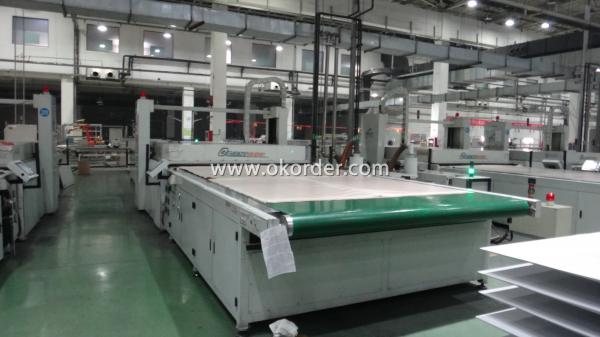
- Q: Making a solar panelI know there was a recommended wattage for the soldering iron but i cant rememberdoes anyone know?
- Rosin okorder /
- Q: Got a quote for about $K today for solar panels to save me about $00 a month on my electric bill. I was just wondering if anyone had successfully bought and installed their own and how it worked for you?
- i do no longer yet i comprehend lots on the venture. e mail for information. a great number of ppl set up them yet just to cover there electric powered warmth/air. It saves them money. i comprehend lots of people who've tiny ones exterior there window to means the lights fixtures in that one room. Its no longer an eye fixed sore the two. i stay in Canada.
- Q: How do solar panels affect insurance premiums?
- Solar panels can potentially lower insurance premiums due to the reduced risk of fire and environmental damage associated with renewable energy systems. However, the impact on insurance premiums can vary depending on factors such as the location, type of solar panel system, and the insurer's policies. It is advisable to discuss these specifics with your insurance provider to determine the exact effect on premiums.
- Q: Can solar panels be installed on a billboard or signage?
- Yes, solar panels can be installed on billboards or signage.
- Q: i have a 2v 2a solar panel that i want to use to charge a 2v battery .Have found out that i need a charge controller so i don't over charge the battery.I have found a cheep one its 2v but 7a will it still work ?All-so im planing on running a 2v water pump off the battery with a timer,its for watering my garden.Will the timer have to be 2v as well ?any help on this would be greatly appreciated thanks .
- The charger will accept whatever current is necessary from the solar panel up to 7A. It's not like the solar panel will force 2amps into the charger/battery -- the charger will control the current going to the battery. I question whether or not the 2V panel will actually charge the battery, though, because in order to charge a standard lead-acid 2V battery you need to have about 4.5 volts applied to the terminals. Perhaps the charger has a boost circuit -- I don't know without looking at it or knowing the brand/model number, etc. The timer must be 2VDC, but, if you only have a timer that is rated for 20VAC, you can buy a small inverter that will take 2V and supply the necessary 20VAC. An inverter rated for 20 to 50 Watts should be sufficient. These usually cost under US$25. .
- Q: Can solar panels be installed on a pergola or gazebo structure?
- Yes, solar panels can be installed on a pergola or gazebo structure. These structures provide a suitable surface for mounting solar panels and can help maximize the exposure to sunlight, ultimately increasing the energy production of the panels. It is important to ensure that the pergola or gazebo is structurally sound and properly designed to support the weight and wind load of the solar panels. Additionally, the orientation and angle of the panels should be optimized for the specific location to maximize energy generation.
- Q: Solar panel for battary charging
- Check the rating on the battery. Either look on the label, or look up the exact manufacturer's part number on the internet. There should be an amp-hour (AH) rating. It's very doubtful that the battery is 65 AH, by the way. When you get the amp-hour rating, people can advise you further.
- Q: Are solar panels affected by shade?
- Yes, solar panels are affected by shade. When a solar panel is partially shaded, it can experience a decrease in efficiency and generate less electricity. Shade can create "hot spots" on the panel, leading to the overall reduction in power output. Therefore, it is important to install solar panels in areas with minimal shade to maximize their energy production.
- Q: Does any one know how to make a solar panel or a type of Alternative energy maker. Best answer gets 0 points
- How image voltaic Cells artwork by skill of Scott Aldous interior this text a million. introduction to How image voltaic Cells artwork 2. Photovoltaic Cells: changing Photons to Electrons 3. How Silicon Makes a image voltaic cellular 4. Anatomy of a image voltaic cellular 5. ability Loss in a image voltaic cellular 6. image voltaic-powering a house 7. fixing image voltaic-ability subject concerns 8. image voltaic-ability execs and Cons 9. plenty extra tips 0. See all actual technology articles you have probable seen calculators that have image voltaic cells -- calculators that for the time of no way want batteries, and from time to time do not even have an off button. as long as you have adequate easy, they seem to artwork continuously. you're transforming into seen better image voltaic panels -- on emergency street indications or call bins, on buoys, even in parking plenty to ability lights fixtures. besides the undeniable fact that those better panels are not as common as image voltaic powered calculators, they are obtainable, and not that stressful to discover in case you comprehend the place to look. There are image voltaic cellular arrays on satellites, the place they are used to ability the electrical powered structures. you have probable additionally been listening to with reference to the image voltaic revolution for the final 2 many years -- the thought that at some point we are able to all use unfastened electricity from the solar. that's a seductive promise: On a vivid, sunny day, the solar shines approximately a million,000 watts of ability consistent with sq. meter of the planet's floor, and if we could assemble all of that ability we could extremely ability our homes and workplaces for unfastened.
- Q: Can solar panels generate electricity during a blackout?
- No, solar panels cannot generate electricity during a blackout. This is because most solar panel systems are grid-tied and rely on the electricity from the power grid to function. When there is a blackout, the grid-tied solar panels automatically shut off to prevent any electricity from flowing back into the grid, in order to protect utility workers who may be repairing the power lines. However, it is possible to have a backup battery system installed along with the solar panels, which can store excess energy and provide electricity during a blackout.
Send your message to us
Business-Grade Monocrystalline Silicon Solar Panels
- Loading Port:
- Shanghai
- Payment Terms:
- TT
- Min Order Qty:
- 1 watt
- Supply Capability:
- 100000/month watt/month
OKorder Service Pledge
OKorder Financial Service
Similar products
Hot products
Hot Searches
Related keywords

